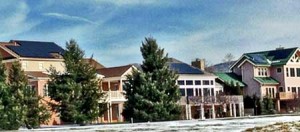More homes switch on solar power at Penn National
Here is an article from our local Newspaper. If you are interested in Solar, we encourage it.
 FAYETTEVILLE - Len Lindenmeyer, one of the first homeowners in Penn National development to install solar arrays, calculates that his electric bills have declined by 72 percent over the past two years."I typically have six or seven months with a zero bill and the rest of the months are substantially reduced," he said.Seventeen homes in Penn National, south of Fayetteville, derive some of their power from solar energy, he said.High sun angles and long days make May through August the peak months for energy produced from the photovoltaic panels on his roof."About 10 to 11 percent of your total power for the year will be produced in each of those four months," he said. "January and December see production totals of approximately 5 percent each month."Daylight lasts just nine or 10 hours a day in November through February, compared to 12 to 14 hours during summer days.
FAYETTEVILLE - Len Lindenmeyer, one of the first homeowners in Penn National development to install solar arrays, calculates that his electric bills have declined by 72 percent over the past two years."I typically have six or seven months with a zero bill and the rest of the months are substantially reduced," he said.Seventeen homes in Penn National, south of Fayetteville, derive some of their power from solar energy, he said.High sun angles and long days make May through August the peak months for energy produced from the photovoltaic panels on his roof."About 10 to 11 percent of your total power for the year will be produced in each of those four months," he said. "January and December see production totals of approximately 5 percent each month."Daylight lasts just nine or 10 hours a day in November through February, compared to 12 to 14 hours during summer days.
Lindenmeyer said the solar market has changed in the two years since it caught on in Penn National:
- The Pennsylvania rebate that attracted some homeowners to solar is gone. That rebate averaged about $8,000 or more for those who acted early. The 30 percent federal credit is still in effect.
- The price of solar has declined by about $1.75 per watt as more solar panels are installed. Increased competition and greater production have led to lower prices. The net cost of an array after rebates and credits will be the same in 2013 as it was in 2010, given all the changes.
- Incentives from one program have declined substantially. Pennsylvania remains one of the few states with open borders, so people having solar in some states, such as Ohio, may sell their renewable power in Pennsylvania. As a result, supply currently exceeds utility demand. Declining prices from solar renewable energy certificates are a result of House Bill 1580 being held in committee.
- Solar power is about 95 to 98 percent efficient, because the power is generated at the point of use. Grid power is about 35 percent efficient. Power is lost in transmission, distribution and transformers.
- Pennsylvania has been among the top five states in the country in the growth of solar during the past two years.
----------
The author is Jim Hook. He can be reached at 262-4759 and jhook@publicopinionnews.com.


